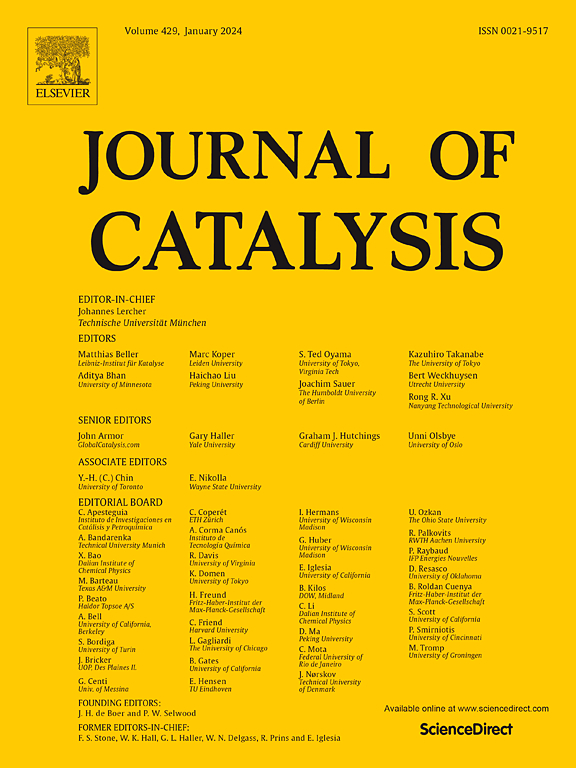Size-dependent effects of Ge addition on the coking and sintering tendency of PtnGem/alumina (n = 4,7,11) model catalysts
IF 6.5
1区 化学
Q2 CHEMISTRY, PHYSICAL
引用次数: 0
Abstract
The reactivity and adsorbate binding properties of alumina-supported Ptn and PtnGem (n/m = 4/1, 7/2, 11/4) model catalysts were studied using a combination of ethylene and CO temperature-programmed desorption (TPD), He+ ion scattering (ISS), and detailed density functional theory (DFT). The Ptn/alumina catalysts gradually deactivated in repeated CO TPD runs and deactivated more rapidly in repeated ethylene TPD runs due to the effects of sintering and carbon deposition (coking). PtnGem/alumina catalysts were dramatically more stable against deactivation by both sintering and coking. Carbon addition to Ptn/alumina also increased stability against sintering, but not coking. Ion scattering was used to probe the nature of adsorbate binding, including the effects of both carbon and Ge addition on the accessibility of strong Pt-associated binding sites for ethylene and CO. DFT was used to examine the electronic and geometric structures and ethylene and CO binding properties of Ptn (n = 4, 7) with added Ge, carbon, or both. Consistent with the ISS results, DFT shows that loss of strong adsorbate binding sites mostly resulted from changes to the electronic properties of the clusters, rather than simple blocking of binding sites by Ge or carbon.

添加Ge对PtnGem/氧化铝(n = 4,7,11)模型催化剂焦化和烧结倾向的影响
采用乙烯- CO程序升温解吸(TPD)、He+离子散射(ISS)和详细密度泛函数理论(DFT)相结合的方法研究了氧化铝负载Ptn和PtnGem (n/m = 4/ 1,7 / 2,11 /4)模型催化剂的反应性和吸附性质。由于烧结和积碳(焦化)的影响,Ptn/氧化铝催化剂在重复的CO TPD中逐渐失活,而在重复的乙烯TPD中失活得更快。PtnGem/氧化铝催化剂在烧结和焦化过程中都具有显著的稳定性。向Ptn/氧化铝中添加碳也增加了抗烧结的稳定性,但没有增加焦化的稳定性。离子散射用于探测吸附质的结合性质,包括添加碳和Ge对pt相关强结合位点对乙烯和CO的可及性的影响。DFT用于检测添加Ge、碳或两者的Ptn (n = 4,7)的电子和几何结构以及乙烯和CO的结合性能。与ISS的结果一致,DFT表明,强吸附结合位点的损失主要是由于簇的电子性质的变化,而不是简单地被Ge或碳阻断结合位点。
本文章由计算机程序翻译,如有差异,请以英文原文为准。
求助全文
约1分钟内获得全文
求助全文
来源期刊

Journal of Catalysis
工程技术-工程:化工
CiteScore
12.30
自引率
5.50%
发文量
447
审稿时长
31 days
期刊介绍:
The Journal of Catalysis publishes scholarly articles on both heterogeneous and homogeneous catalysis, covering a wide range of chemical transformations. These include various types of catalysis, such as those mediated by photons, plasmons, and electrons. The focus of the studies is to understand the relationship between catalytic function and the underlying chemical properties of surfaces and metal complexes.
The articles in the journal offer innovative concepts and explore the synthesis and kinetics of inorganic solids and homogeneous complexes. Furthermore, they discuss spectroscopic techniques for characterizing catalysts, investigate the interaction of probes and reacting species with catalysts, and employ theoretical methods.
The research presented in the journal should have direct relevance to the field of catalytic processes, addressing either fundamental aspects or applications of catalysis.
 求助内容:
求助内容: 应助结果提醒方式:
应助结果提醒方式:


